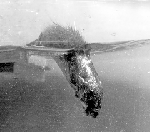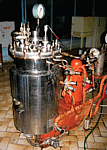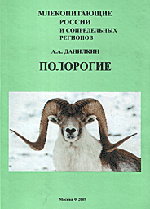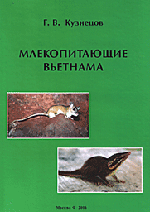
 | Laboratories \ Laboratory for Ecology and Functional Morphology of the Higher Vertebrates \ Goals and Tasks |
| Goals and Tasks |  | Publications |  | Scientific Staff |
 |
LABORATORY FOR ECOLOGY AND FUNCTIONAL MORPHOLOGY OF THE HIGHER VERTEBRATES
MAIN GOALS AND TASKS
Dr. Biol. Sci. E.I. Naumova 
Academician V.E. Sokolov 
Bacterial association on the stomach epithelium 
The hair covering of semi-aquatic mammals - a prospective model for the study of the patterns of morphological and functional transformations in the process of evolution 
Molars of mammoths out of Pleistocene sediments in the region of the river Old Craw (Yukon, Canada) are morphologically similar to the teeth of the mammoth of Northern-Eastern Siberia (from Sher et al., 2005) The members of the Laboratory since the time of its formation in 1998 have been carrying out complex interdisciplinary studies, which actually correspond to six of totally twelve areas of basic scientific researches prioritized by Department of Biological Sciences of RAS, namely: 6.2. Ecology of organisms and communities; 6.3. Biological diversity; 6.4. General genetics; 6.9. Biophysics. Radiobiology. Mathematical modes in biology. Bioinformatics; 6.10. Biotechnology; 6.12. Evolutionary, ecological physiology, the systems of human life-support and protection. The studies are undertaken on a wide range of biological objects, practically embracing the whole spectrum of biological organizations, from molecules to biocenoses. The results of these experimental and theoretical researches allow formulation and successful solution for a good deal of applied scientific problems. In particular, on the basis of the study of trophic endosymbiosis in digestive system of rodents, development of industrial biotechnological processes has begun. The results of phylogenetic and taxonomic studies based on modern molecular-genetic and morphometric approaches combining with ecological and zoogeographic studies set a basis for practical recommendations on conservation of several mammalian species. The most important achievements of the Laboratory in basic and applied researches for the latest years are listed below. Nitrogen-fixing bacterial activity has been discovered in digestive tract of more than 15 species of mammalian herbivores in collaboration with microbiologists of MSU Department of soil sciences. The species composition of nitrogen-fixing bacteria has been determined in 6 rodent species, the functional relationships of diazotrophic-cellulolytic complex of the inner feed chains have been revealed. A possible contribution of nitrogen-fixing bacterial complex into nitrogen balance of mammalian herbivores has been inferred. An important mechanism has been described which allows small herbivorous mammals to maximize nutrient extraction from plant food (including structural carbohydrates as their components). It is shown that the food consumed by rodents is then divided into fast and slowly transferred fractions which localize in different parts of digestive tract where they become subjected to simultaneous fermentation by endogenous and symbiotic enzymatic systems. Mutualistic interactions between microorganisms and animals were studied, symbiotic bacteria producing biologically active substances have been separated, and their application as probiotic feeding supplements for farm and other domestic animals has been developed. Interactions were established between hosts and the microorganisms living on their skin, within their specific cutaneous glands, at inner lining of reproductive system and in large intestine.  
The process of production of the preparation with probiotic effect based on Bacillus subtilus, isolated out of the caecum of wood-grouse 
The genus of Saiga was removed from the subfamily of Capra and referred to antelopes 
On the basis of the study of physicochemical conditions of vital activity of symbiotic bacteria in the caecal chymus of herbivorous vertebrates the principles of usage of intestine bacillus, B. subtilis, for solid-phase fermentation of plant fiber waste products have been established. Original two-phase technology for obtaining probiotic preparations to stimulate animal digestion has been elaborated. On the basis of experimental research of insulative and mechanical properties of mammalian fur advanced approaches have been suggested allowing objective quantitative study of variations in the fur basic morphological features taken from the point of view of their importance for animal heat insulation. Several criteria have been suggested for morphological and functional similarity of the fur as an insulative structure, the criteria establish non-dimensional quantitative ratios between the fur basic structural variables such as hair length, density and thickness. These criteria of similarity have been successfully applied, in particular, for detailed interpretation of adaptive significance of the structural transformations of the fur of semi-aquatic mammals at different phases of their adaptation to aquatic environment. New data have been obtained supporting the concept of evolution of the mammoth fauna in Eastern Siberia for the latest 50 years, which is mainly based on the notion about existence and transformations of graze ecosystems of a tundra-steppe type. A new model for the evolution of the elephants of the mammoth line in Eurasia has been suggested, according to which (as opposite to the existing scheme of gradual autochthonic transformation of the mammoth species in Europe) the ancestors of mammoths, while coming into Europe from Africa 3.5 mln years ago, distributed up to China and then (about 1.5 mln years ago) to the east up to the north of Siberia, where in the process of adaptation to severe conditions prevailed there they attained an appearance characteristic for genuine mammoths of the Ice Age. Afterwards, following the climate changes these forms re-immigrated back to Europe. The study of the fossils of disappeared representatives of the tribe of Ovibovini in the collections of Russia, Europe and USA confirmed a high taxonomic variability of this group and a significant role of Beringida in its evolution. The use of molecular genetic methods (the study of ancient DNA from fossil bones) allowed to clarify phylogenetic relationships between horses of the Old and New Worlds and to reveal the history of their populations in Beringida (the north-east of Asia and Alaska) and North America. Comparative morphological, molecular and cytogenetic methods allowed the detailed description of the systematic status of variety of mammals and in some cases the modification of the current views on phylogenetic relations within Cricetidae, Myoxidae, Cervidae, Bovidae and Viverridae families. Two new subspecies have been described: Gerbillus rupicola and Taterillus tranieri sp (Rodentia, Cricetidae, Gerbillinae). Musk-deers (Moschidae), in contrast to existing concepts, have been juxtaposed with the ancient cavicorns. The Saiga genus was retrieved from the subfamily of goats (Capra) and was referred to antelopes. A conclusion has been made about a basal position of the genus of Ovis relative to the genus of Capra that contradicts to accepted view on their phylogenetic closeness and, in the future, prevents practitioners from unsuccessful attempts to hybridize representatives of these genera. The evidences have been obtained for the existence of only two polytypic sheep species, the Ovis ammon and the Ovis canadensis, instead of 4-7 currently distinguished species. Karyotype of the Geneta johnstoni has been described for the first time and its comparison with the karyotypes of other genetas was carried out, which demonstrated the high resolution of cytogenetic methods for detection of intraspecific differentiation within the genus of Geneta. Long-term studies of the mammalian fauna of Vietnam have been summarized and published in a form of a species-oriented monograph review of Vietnamese mammals. Specific high-altitude zonality in the distribution of the mammals in the mountains of Vietnam has been determined and their specific reaction to anthropogenic load been clarified. It is shown that reasonable sampling cutover patches (up to 30% withdrawal) did not affect rodent fauna composition and the animal population. Complex estimation of the resources of all wild Ungulata species in Russia was made. It has been determined that their total number is about 2.5-2.8 mln at a potential of 17-20 mln individuals. The strategy and methodology of conservation, extended reproduction and efficient use of the most important species of wild Ungulata under new economical and social conditions has been developed. The first time published floristic lists for 5 Reserves and new versions of the floristic lists for 3 Reserves have been included into the database "Vascular Plants of Russian Reserves". After that, the additions and changes for 16 Reserves have been taken into account. At present, the floristic materials for 93 Reserves have been collected, and the floristic lists for 78 Reserves can be considered as completely finished. The works on creation of the floristic lists for 7 more Reserves (Visherskiy, Polistovskiy, Rdeiskiy, Tigirekskiy, "Erzi", Yuganskiy and Yuzhno-Ural'skiy) continue. The joint analysis of the database "Natural relatives of the cultivated plants of Russia" (VIR, Saint-Petersburg) and "Vascular plants of Russian Reserves" (SIEE RAS) in 93 Reserves (out of total 100 ones by November 2005) has revealed vegetation of 1148 species of cultivated plants relatives, which belong to 146 genera and 39 families (71.2% of their total number in Russia and 14.5 % of vascular plants flora known at present in Reserves). The achievements described above are reflected in the provided by the Laboratory stuff members list of publications and in the theses they have defended within the period from 2002 to 2006. |